
From the earliest civilisations right up to the start of the Industrial Revolution, humans used sheer muscle power, organisation skills and ingenious mechanics to lift weights that would be impossible to handle by most power cranes in operation today.
The most powerful hand crane in history multiplied the force of its operator 632 times
The most common tower crane used in construction today has a lifting capacity of some 12 to 20 tonnes. For quite a few construction projects in ancient history, this type of crane would be completely inadequate.
The majority of stones that make up the almost 140 discovered Egyptian pyramids have a weight of “only” 2 to 3 tonnes each, but all of these structures (built between 2750 and 1500 BC) also hold stone blocks weighing 50 tonnes, sometimes more. The temple of Amon-Ra at Karnak contains a labyrinth of 134 columns, standing 23 metres (75 feet) tall and supporting crossbeams weighing 60 to 70 tonnes each.
The 18 capital blocks of Trajan’s column in Rome weigh more than 53 tonnes and they were lifted to a height of 34 metres (111 feet). The Roman Jupiter temple in Baalbek contains stone blocks weighing over 100 tonnes, raised to a height of 19 metres (62 feet). Today, to lift a weight of 50 to 100 tonnes to these heights, you need a crane like this.
Occasionally, our forebears lifted even heavier stones. The gravestone of Theoderic the Great in Ravenna (around 520 AD) is a 275 tonne stone block that was lifted to a height of 10 metres. The temple dedicated to Pharaoh Khafre in Egypt is made up of monolithic blocks weighing up to 425 tonnes.
The largest Egyptian obelisk weighed more than 500 tons and stands more than 30 metres tall, while the largest obelisk in the Kingdom of Axum in Ethiopia (4th century AD), raised up to a similar height, weighed 520 tonnes. The Colossi of Memnon, two statues of 700 tonnes each, were erected to a height of 18 metres and the walls in the Roman Baalbek temple complex (1st century BC) contain almost 30 monoliths weighing 300 to 750 tons each. Only the most powerful contemporary cranes could handle stones of this weight.
Raising construction materials to impressive heights seemed to be no problem either. The Alexandria lighthouse (3rd century BC) stood more than 76 metres (250 feet) tall. The Egyptian pyramids rise up to 147 metres. During the Middle Ages some 80 large cathedrals and around 500 large churches were built with a height of up to 160 metres - out of reach for all but the most recent top model crawler cranes.
Human lifting power
Considering the type of cranes that would be needed today, one wonders how our forebears were able to lift such impressive weights without the help of sophisticated machinery. The fact is, they had advanced machinery at their disposal. The only difference with contemporary cranes is that these machines were powered by humans instead of fossil fuels.
Basically, there is no limit to the weight that humans can lift by sheer muscle power. Nor is there a limit to the height to which this weight can be lifted. The only advantage that fossil fuelled powered cranes have brought us, is a higher lifting speed.
Of course, this does not mean that one man can lift anything to any height, or that we can lift anything to any height if we just bring enough people together. But, starting more than 5,000 years ago, engineers designed a collection of machines that greatly enhanced the lifting power of an individual or a group of people.
Lifting devices were mainly used for construction projects, but (later) also for the loading and unloading of goods, for hoisting sails on ships, and for mining purposes.
The only advantage that fossil fuel powered cranes have brought us, is a higher lifting speed
Initially, the lifting speed of lifting machines was extremely low, while the amount of man power required to operate them remained very high. Towards the end of the nineteenth century, however, just before steam power took over, human powered lifting devices became so elaborate that one man could lift a 15 tonne truck in no time, using only one hand.
Mechanical advantage
Any lifting device has a certain mechanical advantage (MA), the factor by which it multiplies the input force into an output force. A lower input force must always be applied over a greater distance than the greater output force travels, and the ratio of the distances is the velocity ratio (VR).
In theory, the mechanical advantage (MA) = the velocity ratio (VR), so that in a machine with a mechanical advantage of 2 to 1, the input force is half the output force but must be exerted over twice the distance. In practice, friction always reduces the ideal mechanical advantage of a machine.
Ramps & levers
Although some think that the Egyptians had more sophisticated lifting machinery at their disposal, most historians agree that the Egyptians made use of only the most simple lifting devices: inclined planes (ramps and levers (the principle of a seesaw or teeter-totter). Ramps were (probably) also used to raise obelisks.
By moving an object up a ramp rather than completely vertical, the amount of force required is reduced at the expense of increasing the distance it must travel. The mechanical advantage of an inclined plane equals the length divided by the height of the slope. The mechanical advantage of a lever is the distance between the fulcrum and the point where the force is applied, divided by the distance between the fulcrum and the weight to be lifted.



While the methods of the Egyptians offered a considerable mechanical advantage over simply pulling up the load vertically by means of a rope, the required man power remained very high: not only to tow or flip over the stones (it must have taken around 50 men to tow a 2.5 tonne stone block), but also to build and later remove the enormous earthen ramps.
Historians estimate that the workforce to build a pyramid consisted of 20,000 to 50,000 men, sometimes more. While a structure like that could be built today in a few years time with power cranes and a small workforce, most pyramids took decades to complete.
Birth of the crane: the pulley
The first cranes appear in Greece from about the late 6th or early 5th century BC. The Romans, more eager to build large monuments, adopted the technology and developed it further. The earliest cranes consisted of a rope passed over a pulley. Before it found an application in the lifting of objects, the single pulley was used from the 8th or 9th century BC onwards for drawing water from wells (the shaduf).
A single pulley offers no mechanical advantage in itself, but it changes the direction of pull: it is easier to pull down instead of haul up. Pushing vertically upwards with one hand generates about 150 Newton, while pushing vertically downwards with one hand generates about 250 Newton (source).
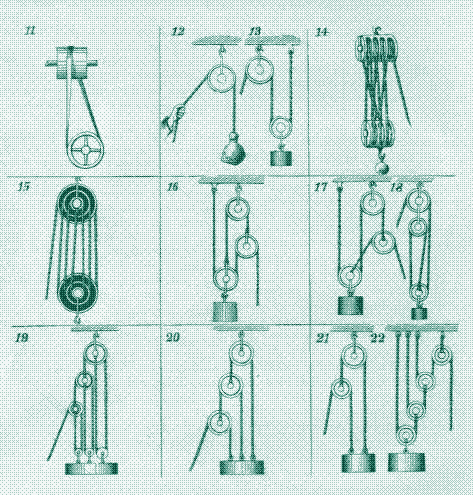
Gradually, the mechanical advantage of cranes was increased with additional technology. A major improvement from the 4th century BC and still in use today, is the compound pulley: a combination of single pulleys in a block. The mechanical advantage equals the amount of pulleys used.
A crane with a triple pulley (a “Trispastos”) has two pulleys attached to the crane and a free pulley suspended from them. It offers a mechanical advantage of 3 to 1. A crane with five pulleys in a similar arrangement (dubbed a “Pentaspostos”) offers a mechanical advantage of 5 to 1.
Using a compound pulley a man can lift more than he is otherwise able to. If a single man pulling a rope can exert a force of 50 kg, he can raise (or lower) 150 kg using a Trispastos and 250 kg using a Pentaspostos. The same goes for the rope. A rope with a tensile strength of 50 kilograms can be used to lift (or lower) 150 kilograms if 3 pulleys are used, and 250 kilograms if 5 pulleys are used.
A crane with five pulleys allows you to lift five times more than you are otherwise able to - but the rope has to be pulled over five times the distance
The downside of the compound pulley is, again, distance and thus lifting speed. Lifting a load 3 metres using a Trispastos will require pulling the rope for 9 metres, lifting a load 3 metres using a Pentaspastos will require pulling the rope for 15 metres.

In theory, any number of pulleys can be used, but because of friction ancient systems were limited to five pulleys. If more lifting power was needed, rather than increasing the number of pulleys within each block, the Romans used two or more 3- or 5- pulley sets, with different gangs working each (a “Polyspastos”). Of course, every rope could also be pulled by several men at once. The power loss due to friction for Roman (and medieval) cranes is estimated to be 20 percent at most (source).
Winches and capstans
Another improvement was the introduction of the windlass (or winch) and the capstan, which both substitute for the pulling of the rope. They were invented around the same time as the compound pulley. The only difference between the winch and the capstan is that the former has a horizontal axle and the latter has a vertical one.
Both use handspikes or levers inserted into slots on a drum to gain a mechanical advantage in circular rotation, given by the radius of the handspike to the radius of the drum or axle. The mechanical advantage of a winch is the radius of the axle to the radius of the handspikes.


Therefore, an axle of 5 centimetres (2 inches) with handspikes 30 centimetres (1 ft) long has a mechanical advantage of 6 to 1. A man operating the winch can thus lift 6 times more than he would when just pulling a rope. However, to wind up 1 metre of rope the handspikes would need to be turned 6 metres.
The treadwheel crane remained in use until the end of the 1800s
Combined with the compound pulley, winches or capstans already offer impressive performance. One man operating a Pentaspostos and exerting a force of 25 or 50 kilograms at the winch described above can lift a load of 750 to 1500 kilograms (25 or 50 kg x 6 x 5 = 750 or 1500 kg), while the Egyptians needed 30 to 60 men to haul up a 1500 kilogram stone block up a ramp.
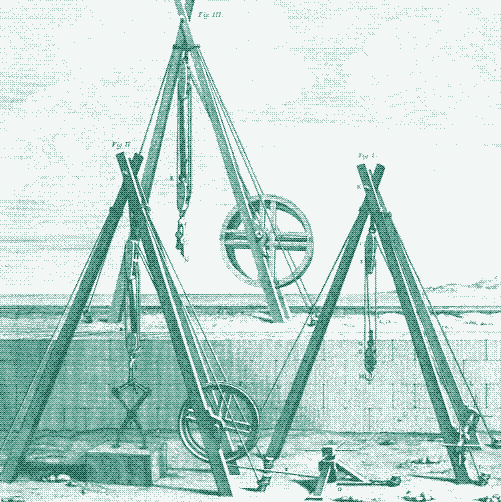
Just like ropes, winches and capstans can be operated by multiple people (winches by two people, capstans by many more). Capstans can also be operated by draft animals. Four men operating a capstan with a similar mechanical advantage as the winch described above, each exerting 25 to 50 kg of power, can lift - ignoring friction - 3 to 6 tonnes (100 or 200 kg x 6 x 5 = 3000 or 6000 kg). However, in both examples, for every metre the load is raised, they will have to pull in 30 metres of rope.
Treadwheels
An even more powerful lifting aid than the winch or capstan was the treadwheel. It was first mentioned in 230 BC and it remained a very important element of cranes up until the second half of the 19th century. Treadwheels, which usually had a diameter of 4 to 5 metres, have a greater mechanical advantage than winches or capstans, because of the larger radius of the wheel compared to the radius of the axle.
Moreover, the power generated by a person’s arm and shoulder is replaced by the greater power of a person walking (not running) within the wheel. A treadwheel with a wheel radius of 7 feet (213 cm) and a drum radius of 0.5 feet (15 cm) has a mechanical advantage of 14 to one. This concerns a treadwheel with a diameter of 456 centimetres: 2 x 213 cm radius of the wheel + 2 x 15 cm radius of the drum (diameter = 2 x radius). (source).
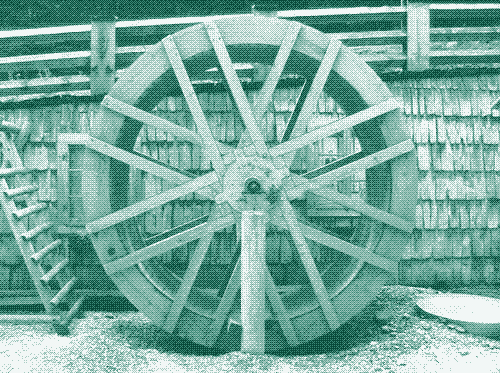
With a mechanical advantage of 14 to one, one man in a treadwheel operating a Pentaspastos and exerting a force of 50 kilograms could thus lift a load of 3500 kilogram or 3.5 tonnes. That’s about 70 times more than he could lift with a simple pulley.
Some cranes (especially the harbour cranes from the middle ages and onwards) were equipped with two treadwheels attached to the same axle, bringing the total lifting power of a human powered crane to some 7,000 kilograms or 7 tonnes.
Because many treadwheels were also wide enough for two people walking side by side, a crane with two treadwheels could be powered by 4 people, which brings the maximum lifting power at 14 tonnes - comparable to that of a common modern tower crane. Even taking into account a loss of 20 percent due to friction, this is still 11.2 tonnes.
A large treadwheel gives a mechanical advantage of 14 to 1
Of course, a mechanical advantage of 14 to 1 also meant that the men had to walk 140 metres inside the wheel to lift a load to a height of 10 metres. If they walk 5 kilometres per hour, the load would be lifted at a speed of 0.35 km/h or almost 6 metres per minute (the velocity of the wheel divided by the velocity of the load = radius of the wheel divided by the radius of the drum).(source).
Lifting towers
While the lifting capacity of a ancient treadwheel crane is impressive, attentive readers will have noticed that Roman buildings contained stone blocks that were considerably heavier than that.
The Romans also shipped a few dozens of obelisks from Egypt and re-erected them in their cities - the heaviest of these weighing more than 500 tonnes. How did they manage this with 6 or 12 ton cranes? Basically, in the same way that we handle very heavy loads, by combining multiple lifting devices.
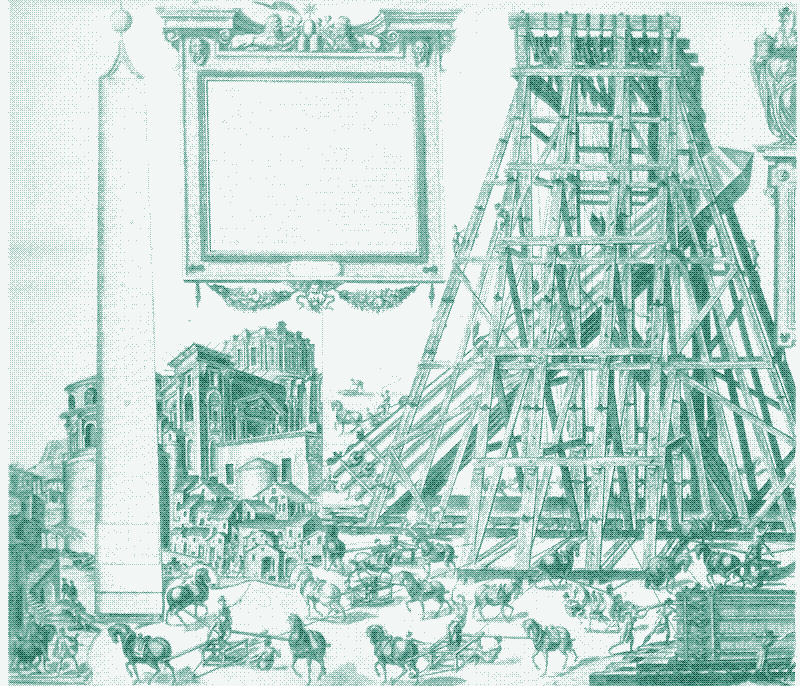
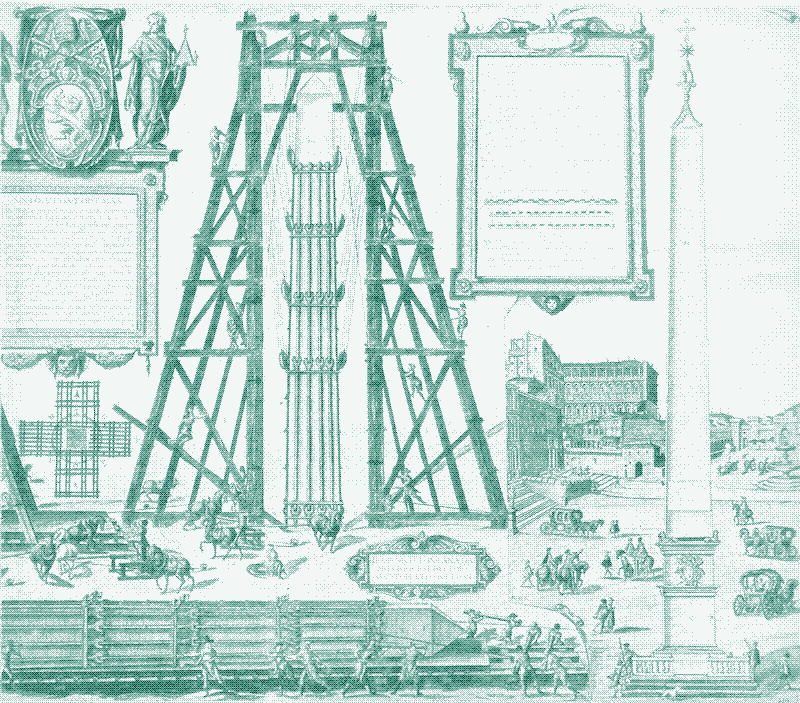
One method was to build a gigantic lifting tower powered by multiple capstans on the ground. Although the mechanical advantage of a capstan is considerably lower than that of a treadwheel, they could be powered by much more people and so less machines would be needed.
Moreover, they allowed for the auxiliary power of draft animals.The method of lifting towers is briefly mentioned by some Roman authors, but detailed information about it comes from an engineer who lived 1000 years later: Domenic Fontana, master builder of the Vatican.
In 1586, Pope Sixtus V decided that the 344 ton obelisk at the Circus Maximus had to move to the square in front of the newly built Saint Peter’s Basilica. A mere 256 metres further, but nevertheless the huge stone had to be lowered, transported, and erected again.
Fontana documented the undertaking extensively in his 1589 book “The movement of the Vatican obelisk”. By then, lifting materials, devices and methods had hardly changed since Roman times, so we can assume that the Romans raised the same stone in a similar manner.
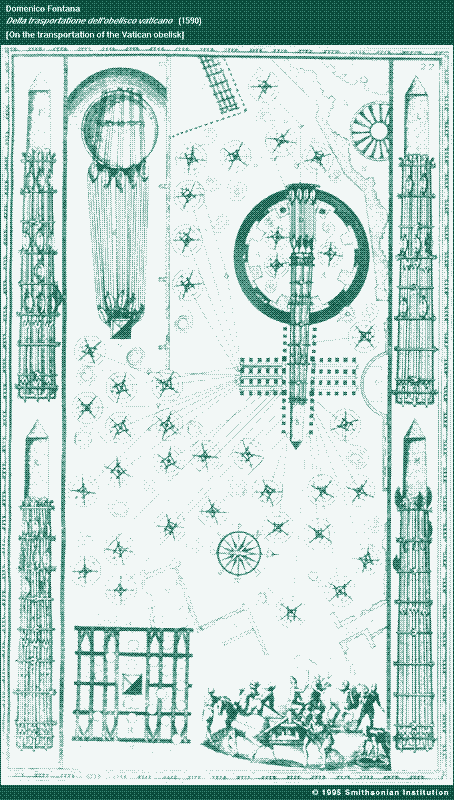
The job was done using a wooden construction 27.3 metres tall, ropes up to 220 metres long, 40 capstans, 800 men and 140 horses (when lowering the obelisk the workforce consisted of 907 men and 75 horses).
While the whole undertaking took more than a year - including the transport of the obelisk (on rollers) and the assembly of the tower, the capstans and other lifting machinery - the stone was erected in just 13 hours and 52 minutes. As a result of this successful operation, many more obelisks were moved around Rome, one of these weighing 510 tonnes.
The obelisk was raised using a wooden lifting tower 27.3 metres tall, ropes up to 220 metres long, 40 capstans, 800 men and 140 horses
The spectators watching the event were ordered not to speak or make any noise under the penalty of death, and police were used to enforce the orders. Silence was crucial in maintaining communication between those monitoring the ropes and pulleys at the top of the tower and those on the ground operating the capstans. The signal to bein turning was given by a trumpet; the signal to stop was given by a bell. (source).
The reinvention of Cranes in the Middle Ages
Following the decline of the Western Roman Empire, the use of elaborate cranes in Europe largely disappeared for more than 800 years. Cranes operated by winches are again recorded from the late 12th century onwards, large treadwheel cranes only reappear in the 13th (France) and 14th (England) centuries - a bit later than windmills and waterwheels. Compared to Roman times, very little technical information was written down during the Middle Ages. Most of our historical knowledge comes from paintings and from illustrations in manuscripts.

Luckily, a few treadwheel cranes have been preserved, all of them in the attics of churches and cathedrals. Large cranes were an absolute necessity in the building of the gothic churches in the late Middle Ages, buildings that were much higher than even the tallest Roman monuments. Furthermore, the working area on these sites was rather limited compared to Roman conditions, and both factors led to a different use of cranes.
Gothic churches and cathedrals
Most probably, cranes were installed inside the building, initially on the ground, and moved upwards (and also sidewards) as the construction work proceeded, being dismantled and reassembled multiple times. When the church was finished, some of these cranes were left above the vaulting and below the roof where they might come in handy for repairs.
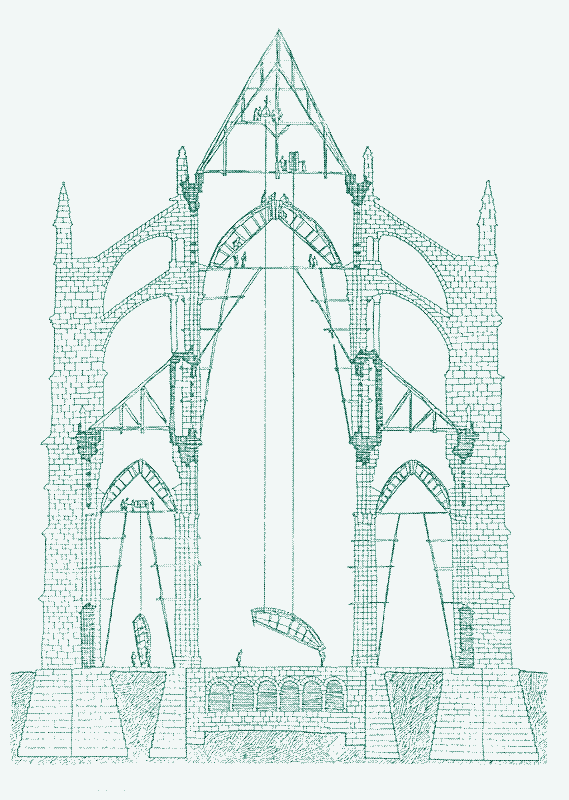
One of these treadwheel cranes, in Britain’s Canterbury Cathedral, was used for a renovation project in the 1970s. It dates from the late 15th century, could accommodate one to two labourers and has a diameter of 4.6 metres.
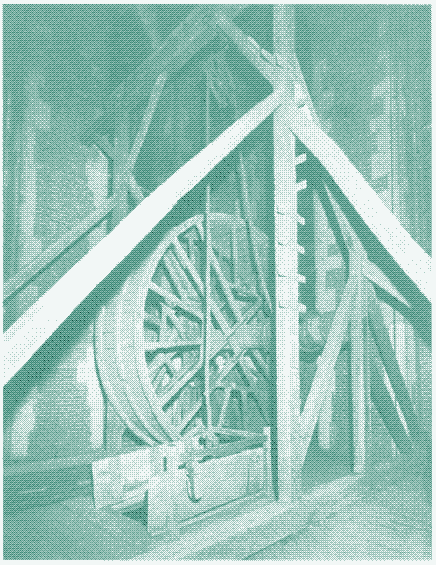
Medieval illustrators sometimes depicted cranes mounted on the outside of the walls, but this was done probably because it made better paintings - the walls of gothic churches and cathedrals were generally too thin to support a heavy crane and its load.
Another well described medieval lifting device is the large treadwheel slewing crane that stood on top of the 157 metre high Cologne Cathedral in Germany for almost 450 years. It was erected in 1400 and dismantled only in 1842. The crane housed two treadwheels, was 15.7 metres high and had a 15.4 metre long jib which could traverse the entire working area - basically functioning like a modern tower crane.
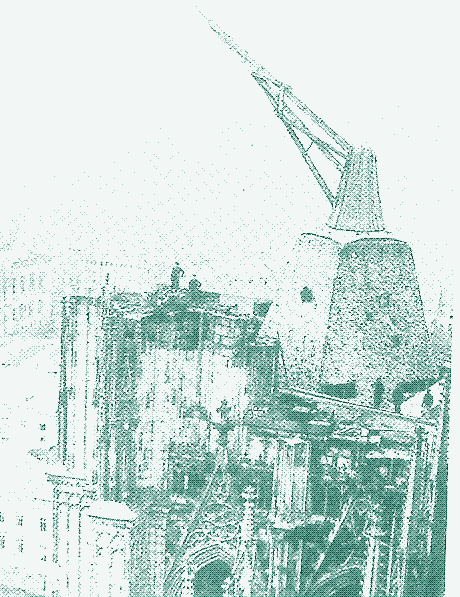
Harbour cranes
A new development in the Middle Ages was the stationary harbour crane, powered by treadwheels. It was not used by the Greeks or the Romans, possibly because they had a large enough reservoir of slave labour at their disposal. The Roman standard shipping container, the amphora, was rather small and could easily and rapidly be loaded and unloaded using a human conveyor belt and a ramp (source).
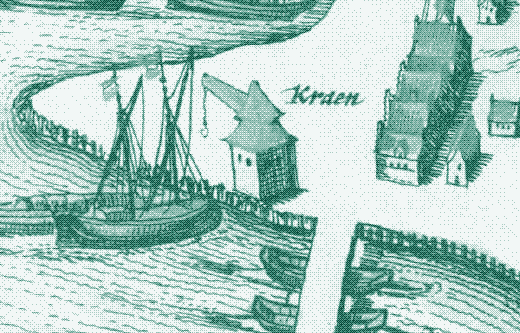
Harbour cranes first appeared in Flanders, Holland and Germany in the 13th century, and in England in the 14th century. They were more powerful than cranes used in construction, and equipped with not one but two treadwheels having a larger diameter of up to 6.5 metres.
These more potent “engines” were not so much aimed at heavier loads but rather at higher lifting (and lowering) speeds. In loading and unloading goods, speed was more important than in construction, where the tempo was dictated by the slow progress of the masons and carpenters.
Built by millwrights
Dockside treadwheel cranes were frequently capped by a wooden roof to protect the mechanics and the workers from the rain. These permanent structures had much in common with windmills, and they were most probably built by the same craftsmen.
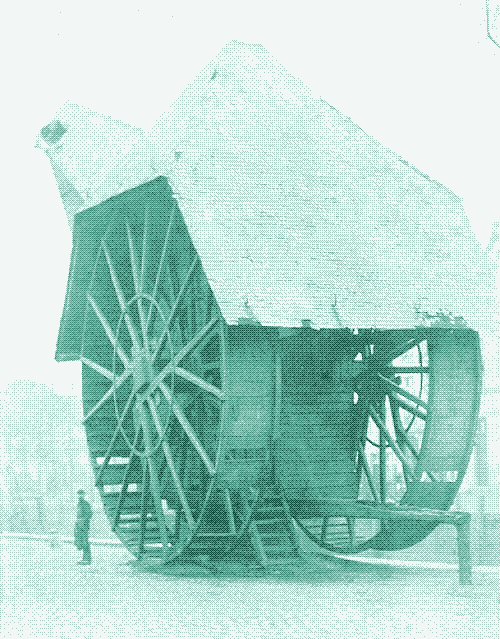
Analogous to post windmills and tower windmills, there were post cranes and tower cranes: the former were wooden structures which pivoted on a central vertical axle, the latter (mostly built in Germany) were masonry towers with only the cap and the jib arm rotating.
Harbour cranes were not adopted in Southern Europe and their total number in the whole of medieval Europe was rather limited compared to the number of windmills: about one hundred large harbour cranes have been discovered (source). Around a dozen of them are still standing.

The most powerful harbour cranes had two treadwheels, each walked by 3 to 4 men
The most powerful treadwheel harbour cranes were built in the London docklands in the 1850s, having two treadwheels of up to 3 metres wide, each walked by 3 to 4 men (source). These are not to be confused with the even wider treadwheels used in 19th century prisons, where the men walked on the outside of the wheel.
More flexible cranes
Today’s cranes can turn their jib 360 degrees (slewing) and move the load horizontally along the jib. Initially, most cranes used in medieval construction work were only capable of a vertical lift. The load could only be manipulated laterally by the crane master on the ground, using a small rope attached to the load. Dockside cranes introduced the slewing crane, of which the first evidence appears in the 14th century. Slewing became a common feature of construction cranes in the 1600s, which shortened work cycles considerably.
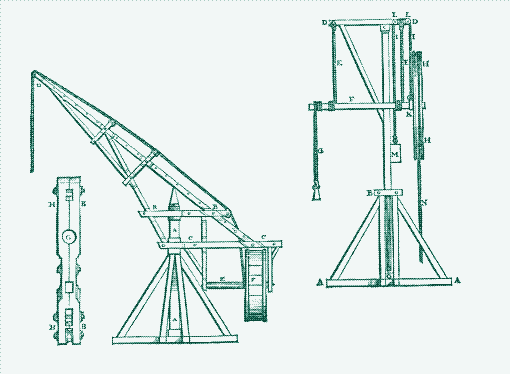
The first crane that allowed a horizontal movement of the load appeared in a 1550 book of Georgius Agricola, but a real-world version was only launched in 1666 by Frenchman Claude Perrault. A trolley was moved along the whole length of the jib by means of a complicated rope system in which two ropes were wound and unwound via a spindle attached to the trolley.
Let’s not forget that Greek and Roman cranes were capable of very limited horizontal movement, too, by lowering or raising the masts a bit. Moreover, the Greeks already designed a kind of slewing crane, which was a lifting device as described earlier but resting only on one mast, directed and kept in balance by extra men on the ground holding ropes. Safety mechanisms (to prevent plummeting loads and sudden reverse rotation of the treadwheel or capstan) were introduced only in the late eighteenth century.
Iron cranes
In the 19th century, three important innovations appeared. The first one was the use of iron instead of wood structures and gearings, which made cranes stronger and more efficient. The first cast iron crane was constructed in 1834. That same year, the wire rope was invented, a much stronger alternative to the natural fibre rope or the metal chain. Finally, in 1851, the third game-changing innovation appeared: the steam-powered crane. With the arrival of steam power, any load could be lifted at any speed, as long as the engine was powerful enough.
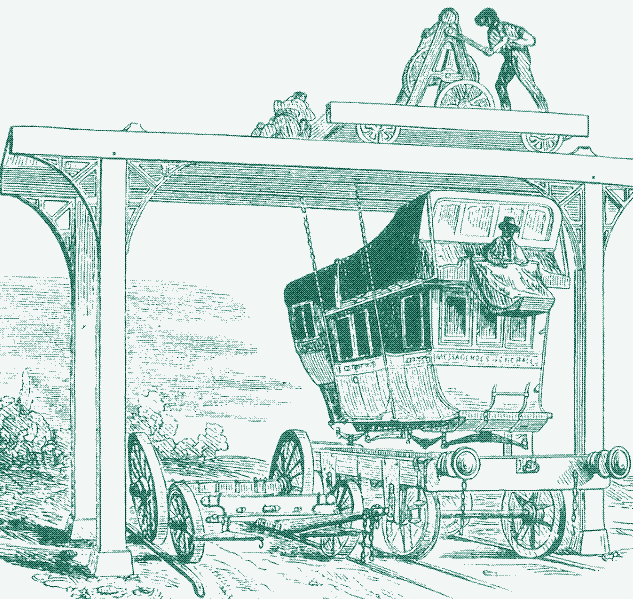
Wire rope was soon in widespread use, but the other two innovations only caught on slowly. Wood, sometimes combined with iron, continued to be the material of choice for many cranes well into the twentieth century, especially in regions where timber was plentiful. And while more and more steam cranes appeared in the second half of the nineteenth century, hand-powered cranes kept being sold and used in large amounts. A book on crane technology, published in 1904, still devoted half of its pages to manually operated cranes. Bicycle cranes were sold, too.
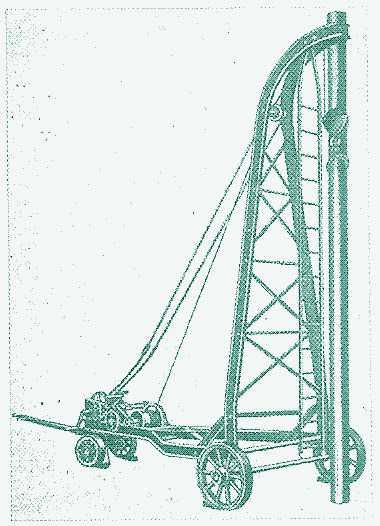
Logically, it was also this era that produced the most powerful muscle powered cranes ever designed: those composed of iron structures and gearworks, using wire ropes, but not yet powered by steam. One peculiar example of this intermediate technology is shown above: a 1843 hand driven gantry crane for transferring carriages. Equally interesting, though made entirely of wood, are the early 1900’s treadwheel cranes in the Netherlands, used to haul up boats over land.

A book on crane technology, published in 1904, still devoted half of its pages to manually operated cranes
The best example, however, are the dockside cranes of William Fairbairn, patented in 1850. Fairbairn riveted together two iron plates, creating an arch-shaped jib that was far more stable and practical than the previous straight wooden or iron jibs. Fairbairn steam cranes became very well known and some of them have been preserved.
Most powerful hand crane ever
Much less known, however, is that for a short time these powerful cranes were sold as hand powered machines. Because Fairbairn described these cranes in detail in the 1860 edition of his book “Useful information for engineers”, we know exactly what the - impressive - mechanical advantage of their gearings was.
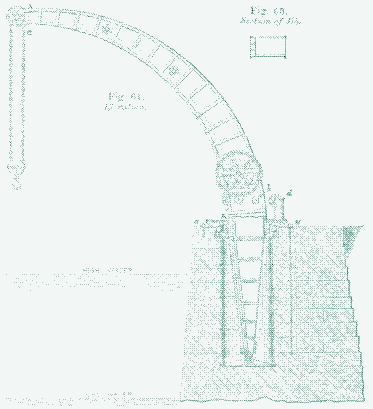
The first hand-driven Fairbairn harbour cranes were intended to lift weights of up to 12 tons to a height of 30 feet (9 metres) above the ground, and to sweep this load round over a circle 65 feet (20 metres) in diameter. Next, a 60 ton crane was built for the new docks at Keyham, which could lift loads five times heavier up to heights of 60 feet (18 metres) and over a circle 104 feet (32 metres) in diameter. It is this “colossal crane”, probably the most powerful hand driven crane ever built, that is described in detail by Fairbairn:
“The chain passes round 4 pulleys, two moveable and two fixed, in the end of the jib. It is then conducted down in the interior of the jib over three rollers to the barrel, which is also in the tube near the ground. On each side of the crane a strong cast iron frame is fixed for receiving the axles of the spur wheels and pinions.”
“Four men, each working a winch of 18 inches radius, act by two 6 inch pinions upon a wheel 5 feet 3.75 inches diameter, this in turn moves the spur wheel, 6 feet 8 inches diameter, by means of an 8 inch pinion, and on the axle of the former the chain barrel, 2 feet in diameter, is fixed.”
“Hence the advantage gained by the gearing will be W/P = 18 x 63.75 x 80 / 6 x 8 x 12 = 158 or taking the number of cogs in each wheel W/P = 18 x 95 x 100 / 12 x 9 x 10 = 158 and as this result is quadrupled by the fixed and moveable pulleys, the power of the men applied to the handles is multiplied 632 times by the gearing and blocks. Two men are sufficient to move round the crane with 60 tonnes suspended from the extreme point of the jib.”
A mechanical advantage of 632 to 1 means that each of the four men had to apply a force of only 23.7 kilograms in order to lift a weight of 60 tonnes - and this while operating a winch instead of a more efficient treadwheel.
We prefer lifting things with power machinery and we run (not walk) on a treadmill in the gym to keep in shape
The most powerful crane in the world today (since September 2009) has a lifting capacity of 20,000 tonnes. If it would be equipped with a gear system offering the same mechanical advantage as that of the above described Fairbairn crane, a weight of 20,000 tonnes could be lifted by 1,265 men each exerting 25 kilograms of power.
This is comparable to the workforce that was required to lift the 340 tonne obelisk in the 16th century. And of course, there is no doubt that we could further improve upon the 19th century gearwork and make the mechanical advantage even higher.
We could lift anything without fossil fuels. Nevertheless, apart from their use by some hardcore ecological architects, human powered cranes have completely disappeared, even for the lightest of loads. We prefer lifting things with power machinery and we run (not walk) on a treadmill in the gym to keep in shape.
Sources (in order of importance)
- “The History of Cranes (The Classic Construction Series)
”, Oliver Bachmann (1997). This book gives a detailed overview of lifting devices from the earliest times to the end of the 20th century. It also showed me the way to many great pictures.
- “The Oxford Handbook of Engineering and Technology in the Classical World
”, John Peter Oleson (2008). Here I found most of the information on the mechanical advantage of lifting devices.
- “Medieval treadwheels: artists’ views of building construction”, Andrea L. Matthies (1992). This study gives an informed look at medieval treadwheel cranes, inluding how to calculate the mechanical advantage of a treadwheel.
- “Useful information for engineers”, William Fairbairn (1860, first edition - all later editions do not contain the chapter on hand powered cranes). This book gave proof of the impressive performance of late hand powered cranes.
- “The construction of cranes and other lifting machinery”, Edward Charles Robert Marks, (1904). Detailed information on late hand powered cranes.
- “Building Trajan’s column”, (.pdf), American Journal of Archeology, Lynne Lancaster (1999). Roman lifting techniques & the use of lifting towers.
- “Heavy goods handling prior to the nineteenth century”, F.R. Forbes Taylor (1963). An overpriced research paper compared to that of Andrea L. Matthies, but it gives some interesting additional information on harbour cranes. Also names an estimation for the amount of medieval dockside cranes in Europe.
- “Crane”, Wikipedia. General introduction, based on two authoritative German books. See also: list of harbour cranes.
- “Claude Philip”, illustrations of ancient cranes
- “Theatrum instrumentorum et machinarum”, Jacobi Bessoni (1582). Ancient and medieval crane types.
- “Engineering in History (Dover Books on Engineering)
”, Richard Shelton Kirby (1990). Extra information on ancient Roman and Egyptian lifting devices.
- “Lifting in early Greek architecture”, The journal of Hellenic studies, JJ Coulton (1974).
- “Rudimentary treatise on the construction of cranes and machinery”, Joseph Glynn (1849)
Reactions
To make a comment, please send an e-mail to solar (at) lowtechmagazine (dot) com. Your e-mail address is not used for other purposes, and will be deleted after the comment is published. If you don’t want your real name to be published, sign the e-mail with the name you want to appear.
Reactions
Patience
I wonder what permits are needed if I wanted to build a house with something like this.
I was just thinking on yesterday how we now have need to exercise because we do not do strenuous work anymore.
Thank you for the post. can’t wait for the next 1
Kris De Decker
@ Alexander (#14): when it comes to the Ancients, yes. The medieval and early modern human powered cranes described in the article, however, were not operated by slaves. In fact, the improvement of the technology in the late middle ages was due to a shortage of labour. Technology that allows work to be done faster using less people predates the Industrial Revolution by many centuries.
SpaceHobo
Of course, treadwheels have a terrible problem with hypnosis and vertigo. You’re making walking/climbing motions while staying still, your visual cues for the ground curve up and over your head in front of you, and there is the constant passing of slats providing an effect often called “highway hypnosis” in driving contexts.
It’s to the point where modern health and safety requirements in the UK limit people to something like one minute of treadwheel operation before having to switch off for someone else.
And just consider the failure mode for a treadwheel attached to a 20 tonne weight when the operator trips and falls!
Fuzzy
How about rocks on rocks? Wally Wallington moves 20,000lb rocks by teetering them on an off-center pivot and spinning them: http://theforgottentechnology.com/
DC
It is possible once PO really sets in, we might see a rebirth of mechanical devices like these and others? Could we leverage our new materials and physics knowledge to create devices even more powerful yet lighter and more veratile than ancient methods? Or has too much been forgetten, thus forceing us to re-learn it all over again? I sometimes wonder if our modern engineers would be up to such a task.
Patrick
Nice article! I have an amateur interest in pre-industrial technology and I really enjoyed this piece.
On permits, safety regulations and PO: Modern safety regulations are a result of a number of changes in the reality of labour over the past century or so; it is unlikely that those realities will hold up under a low-oil future.
Oz
This is sort of labor intensive technology would be great for kick starting African industrialization.
Unfortunately in the past too many economic aid projects in the developing world relied on capital intensive inputs which required scarce foreign exchange.
Doug
“… lift weights that would be impossible to handle by most power cranes in operation today…” Respectfully apple to oranges. Today’s construction materials & methods mean we don’t need to construct cranes to lift such weight, but with we had the need were a cable of constructing the machinery. Don’t get me wrong; I’m in awe at to what they where able to do in the past, but I’m equally in awe of our ability to fling craft outside our Solar System as well. Modern safety concerns aren’t going away,, but they will adjust to meet new realities. In the event human power machines are needed they will be built, built SAFELY. Drives me nuts when others suggest has held back progress some in the other comments have.
Roger
Very interesting. This is one of the best sites on the internet.
Space cynic
One possible correction: recent research seems to point to the pyramids being fabricated (I.e. Concrete blocks) and not quarried/dragged/assembled.
If this proves correct, it does make the construction of those buildings much easier to explain.
E.Victor
Be assured that human powered lifting machines are still used today in construction, I’m an engineer and in one of my projects we needed to lift 2 I-beams to the height of 20m (60 feet) and it was done by a group of 3 people with an old manual crab winch !
I was amazed !
Thecat
When I first started work as a steeplejack/rigger in the late 1960’s when it was rare to see a crane, we used a Telegraph Pole(40 ft.long) that was guyed out,as you would a tent pole with an arrangement of ladders, bosuns chairs,winches, tirfors, snatchblocks and other assorted rigging tackle, to erect industrial steel chimneys,often well over 100ft.high. Even today there are still firms that use jacks,skates and timber every day for moving & erecting plant & machinery.
Name respectfully withheld
Fascinating article. A great look, professional layout. Some consistently-made grammatical errors and a physics “error” really leaped out though.
As for the grammatics:
“…could be powered by much more people and so less machines would be needed…”
should have been
“…could be powered by many more people and so fewer machines would be needed…”
That error was made in a number of places in the article. It’s easy to fix, just get your editor to learn that rule: “Amounts of something” vs. “Numbers of something”. Or, just run it through a grammar checker.
Before you think I’m some kind of a crazy stickler for the trivial, consider that there were some errors in physics as well. Both problems reinforced each other to make for some “screaming cognitive dissonance” in the reader (okay, just me :-) ), and also to make you look a little dumb. Sorry.
The physics error was that you referred to the 20% “loss” as if it reduced the force obtainable. Reduced force would be a result of static friction in the system which isn’t really measurable like that. Percent loss is usually a measure of loss of energy, which wouldn’t reduce the amount of force liftable. I don’t think you don’t know the difference between energy and force, but it looked a little bit like you might. And, that’s a pretty important thing given your subject matter.
Alexander Lopez
The author seems to forget that those big ancient erections were made thanks to the usage of massive amounts of cheap manpower, a.k.a. slaves.
Slaves were so cheap and abundant that no one cared about technology or safety. With the arrival of industrial revolution work could be done faster using less people; a tendency that continues today with CNC machinery replacing handiworks.
While it’s important to learn from the past, it’s also important not to forget why those practices fell aside. Great work.
Eugene N.
I’m in 8th grade right now, studying about the six simple machines. We’re currently working on a project called the “Nifty Lifter”, where the minimum requirement is to lift a 600 gram weight 5 cm off the ground with an input of 200 grams. Interested to learn more about how the ancients did it, I went ahead and googled, “Ancient lifting devices”. This site came up, and I was instantly fascinated by your article. I’ve heard about the Roman treadwheel machines before, but ingenuity to the extent of multiplying lifting forces through combining such machines has never occurred to me. The well-written article certainly helped in the reading as well. The words read very smoothly, and I had no trouble understanding the mechanics of such machines. Thank you for this detailed article and very educational site.
Mark Welton
Yes - I found it fascinating too, like many of the other commenters here. And I too was brought up sharp by a certain Physics error. In comparing the inclined plane and the lever, you state that “The mechanical advantage of an inclined plane equals the length divided by the height of the slope. The mechanical advantage of a lever is the distance between the fulcrum and the point where the force is applied, divided by the distance between the fulcrum and the weight to be lifted.” But by the (correct) definitions stated in the previous paragraph, what you have just described is the velocity ratio, not the mechanical advantage. Could be a source of confusion for a student of the subject.
Greg
Alexander Lopez, you are wrong. Yes some were built by slaves. But go to England or Scotland. Most of the extremely impressive architecture such as churches and castles were not built by slaves but craftsman. But you missing the salient point. All your machines are 100% dependent on finite fossil fuel. FINITE. So waffle on making idiotic political statements. The end game is the same.
Too Cautious to Give Out
Thank you soooooooo much! I’m in 7th grade doing a research report on the history of lifting devices, and this site helped sooooooooo much! Again, THANK YOU!
Sue
One aspect of the winch or capstan I did not see and am curious about - sorry I do not know the proper name, but they were (perhaps still are) used on oil rigs for maneuvering heavy equipment around. A horizontally mounted hub spinning under force of the rigs engine, a large rope over a single pulley is used for lifting - i.e. no complex series for additional mechanical advantage, but the rope is instead wrapped around the spinning hub with more wraps for lifting more weight. The result is that a man with one hand can lift several hundred pounds effortlessly.
Does anyone know what this is called, and is or was it used elsewhere?
Slowburn
@ Sue
It sounds like a snubbing winch. They are often used for lifting crab pots. They are good for when you are going to switch ropes you are pulling or the rope is so long that it would make the spool overly large.
Ed Williams
Any Safe ( Portable Powered) way of lifting a 200 lb person to heights of 500 feet on Communication towers?
Mark
Hello Kris,
Hand cranked lifts are still really really popular for certain construction jobs. See for example the Böcker ALP series of construction lifts:
https://www.youtube.com/watch?v=9_TumVaz3MI
P.S. Currently looking for a good low tech lifting/crane mechanism for 400kg straw bales to be used in construction. Any hints welcome!
Thank you for your work on lowtechmagazine!
Mark
quierodecorarte
Very good note. There are still some original antique cranes in good condition. One of them is in the cathedral of Strasbourg. A wheel crane that is a thousand years old. And it can be watched. https://quierodecorarte.com/antigua-grua-de-rueda-en-la-catedral-de-estrasburgo/
William
What type of cranes were used to build the US Capital Building, and The White House? What was the heaviest stone block that could be lifted in the early 1800’s?
Paul Hercules Smith
Latest discovery in egyption stone quarry indcates Egyptins employed a compund machinemade of both rap (incline plane) and multiple pullys-https://www.liverpoolecho.co.uk/news/liverpool-news/liverpool-expert-solves-mystery-pyramids-15382837
RICK HANNAMAN
Great page with a ton of very useful info. I found it while looking for info to build my own (crane?) to move BIG rocks around my property from stockpiles of rock to final building/use site. I have lots of scrap steel and a few old trucks around and some mechanical goods to work with. Pluss extensive welding and electrical background coupled with ambition. Any suggestions, ideas, or web sites, etc would be greatly appreciated. I would need to be able to pick and move boulders from the size of an upright refrigerator on down and be able to lift them up to 24’ vertically.
I am one man with six acres and full of dreams without a lot of financial means. Concrete, a backhoe, and hired labor are out of my reach just as time is to. 61 years of age has endowed me with much knowledge but never enough and a very finite amount of time of which the amount is unknown. So… one foot in front of the other, head down and ass up, shouldering what I can and let the rough end drag are the mottos to live by for me. I will persevere.
Alexandrine Maes
En France, dans la forêt de Guédelon, depuis plus de 20 ans, on construit un chateau avec les techniques du moyen age exclusivement. une grue humaine est utilisée pour monter les matériaux. chantier à visiter: https://www.guedelon.fr/en
Janet Edwards
Hi - Terrific article. I’m writing a novel set in Bruges in 1299, and have a scene featuring the harbor treadwheel crane. Your piece is very informative. I have scoured the only map I have of medieval Bruges and cannot find the snippet of the map you have here, but resolution on the map I’m working from is poor. Perhaps there’s a second map of which I’m unaware. Was that image from Bruges? If so, can you clue me in to a nearby landmark that would help me locate it? (Happy to email you the image from which I’m working)